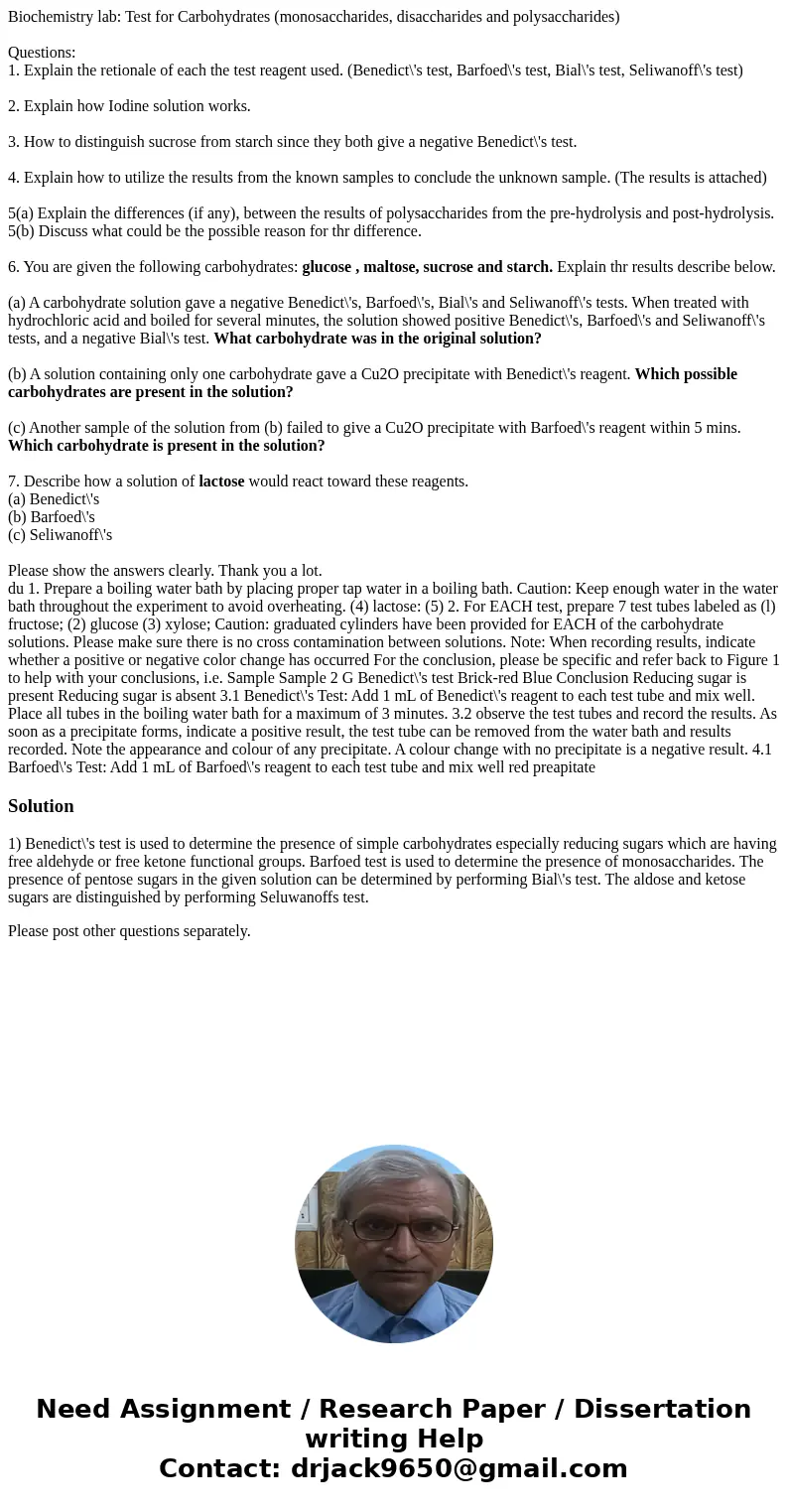Biochemistry lab Test for Carbohydrates monosaccharides disa
Biochemistry lab: Test for Carbohydrates (monosaccharides, disaccharides and polysaccharides)
Questions:
1. Explain the retionale of each the test reagent used. (Benedict\'s test, Barfoed\'s test, Bial\'s test, Seliwanoff\'s test)
2. Explain how Iodine solution works.
3. How to distinguish sucrose from starch since they both give a negative Benedict\'s test.
4. Explain how to utilize the results from the known samples to conclude the unknown sample. (The results is attached)
5(a) Explain the differences (if any), between the results of polysaccharides from the pre-hydrolysis and post-hydrolysis.
5(b) Discuss what could be the possible reason for thr difference.
6. You are given the following carbohydrates: glucose , maltose, sucrose and starch. Explain thr results describe below.
(a) A carbohydrate solution gave a negative Benedict\'s, Barfoed\'s, Bial\'s and Seliwanoff\'s tests. When treated with hydrochloric acid and boiled for several minutes, the solution showed positive Benedict\'s, Barfoed\'s and Seliwanoff\'s tests, and a negative Bial\'s test. What carbohydrate was in the original solution?
(b) A solution containing only one carbohydrate gave a Cu2O precipitate with Benedict\'s reagent. Which possible carbohydrates are present in the solution?
(c) Another sample of the solution from (b) failed to give a Cu2O precipitate with Barfoed\'s reagent within 5 mins. Which carbohydrate is present in the solution?
7. Describe how a solution of lactose would react toward these reagents.
(a) Benedict\'s
(b) Barfoed\'s
(c) Seliwanoff\'s
Please show the answers clearly. Thank you a lot.
du 1. Prepare a boiling water bath by placing proper tap water in a boiling bath. Caution: Keep enough water in the water bath throughout the experiment to avoid overheating. (4) lactose: (5) 2. For EACH test, prepare 7 test tubes labeled as (l) fructose; (2) glucose (3) xylose; Caution: graduated cylinders have been provided for EACH of the carbohydrate solutions. Please make sure there is no cross contamination between solutions. Note: When recording results, indicate whether a positive or negative color change has occurred For the conclusion, please be specific and refer back to Figure 1 to help with your conclusions, i.e. Sample Sample 2 G Benedict\'s test Brick-red Blue Conclusion Reducing sugar is present Reducing sugar is absent 3.1 Benedict\'s Test: Add 1 mL of Benedict\'s reagent to each test tube and mix well. Place all tubes in the boiling water bath for a maximum of 3 minutes. 3.2 observe the test tubes and record the results. As soon as a precipitate forms, indicate a positive result, the test tube can be removed from the water bath and results recorded. Note the appearance and colour of any precipitate. A colour change with no precipitate is a negative result. 4.1 Barfoed\'s Test: Add 1 mL of Barfoed\'s reagent to each test tube and mix well red preapitate Solution
1) Benedict\'s test is used to determine the presence of simple carbohydrates especially reducing sugars which are having free aldehyde or free ketone functional groups. Barfoed test is used to determine the presence of monosaccharides. The presence of pentose sugars in the given solution can be determined by performing Bial\'s test. The aldose and ketose sugars are distinguished by performing Seluwanoffs test.
Please post other questions separately.

 Homework Sourse
Homework Sourse